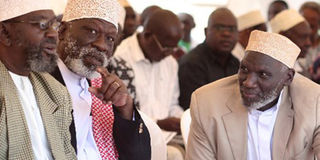Kenyan Nubians and their acceptance struggle

Members of the Nubian Council of Elders (from left to right) deputy Ibrahim Osman, chairman Issa Abdul Faraj, and general secretary Ibrahim Diab. Photo by Emma Nzioka
What you need to know:
Bearing the brunt. In Nairobi’s Kibera slums live thousands of marginalised Kenyans whose ancestors were brought to Kenya from Sudan in the early 1890s to serve as soldiers in the British Army. Although they gave their all to the British empire under the Kings African Rifles service during the building of the Uganda Railway and later in the First and Second World Wars, their uneasy relationship with the colonial masters boiled over into independent Kenya. Now they want an end to the iniquities that include a deliberate attempt not to recognise Kibera as their ancestral home
Sitting outside the battered door to his old family house in the Makina sector of Kibera slums, Hussain gazes at the setting sun as he ponders what the future holds for him. Unlike the fading sunshine that is guaranteed to grace the skies over the world famous shantytown the next day, the 25-year-old’s tomorrow is clouded in uncertainty.
With no national identity card to quantify his citizenship, no college certificate or a godfather in high places, the young man’s destiny looks as gloomy as the rapidly approaching darkness.
Like Hussain, the fate of thousands of Nubian youths residing in Kibera and other places across the country hangs precariously in the ethnic balance.
“When I went to apply (for the ID) the third time, I indicated that I’m a Luo because I speak Dholuo fluently. After giving them my school certificate and photocopies of my parents’ IDs, they asked me to present the death certificate of my grandfather,” he says. “I have never met my grandfather. When he died I wasn’t even born. Back then when people died, no one bothered about certificates and all that nonsense. I think they just want to deny me citizenship.”
Without an identity card, one is virtually a non-entity in Kenya because they cannot get employment, buy property or transact any official business.
Nubian youths usually have to go through a process called “vetting” where they are required to prove their connections to Kenya through documents like grand parents’ birth certificates before they could get an ID. Until recently, the whole process used to be supervised by a “vetting committee” in the Registrar of Persons Office.
“At the age of 18, your life as a Kenyan stops,” one youth from Kibera laments. “It is only when you apply for an ID card that your realise you have been living a lie. This country does not want you and the years you have spent here are all a farce.”
When they finally get the cards, sometimes after waiting for up to three years, landing a job proves even more difficult.
“You have to have someone to introduce you to people who matter,” says Hussain. “But we have no one in politics, no one in government, no one in high places places… we are doomed.”
Big boost
But the Nubians’ quest to change their status from “nowhere people” — a term used to refer to stateless communities — to recognition received a boost last week after American freelance photographer Greg Constantine compiled a pictorial book titled Kenya’s Nubians, Then & Now.
Published in conjunction with United Nations High Commission for Refugees (UNHCR), the book documents the community’s history in photos, personal testimonies and a recount of important dates.
“My motivation for compiling this book was because very little is known about the Nubians despite the fact that the area that they live in has been heavily documented,” Constantine explained during the book’s launch a the pricey Lord Errol Restaurant, Nairobi. “The project also helped me in pushing the agenda of stateless people in Africa.”
The book, expected to be in bookstores across Kenya by January next year, was part of a bigger project called the Nowhere People where Constantine highlights the plight of stateless people in Africa and Asia through photography. The publication joins a rank of initiatives by individuals and lobby groups to advocate the rights of this marginalised community.
Nubians were brought to Kenya and Uganda, then known as the East African British Protectorate, from Sudan in the early 1890s to serve as soldiers in the British Army. Although they gave their all to the empire under the Kings African Rifles (KAR) during the building of the Kenya-Uganda railway line and later in the first and second world wars, their relationship with the colonial masters was never smooth as evidenced by the bloody Uganda Mutiny in 1897.
“After the completion of the Uganda Railway in the first decade of the 20th century, Nubian soldiers and their dependants started settling throughout the country, with the biggest settlement being at “Kibra”, Nubi for ‘forest’, in the soon-to-be founded town of Nairobi,” explains Abdul Faraj, Chairman of the Nubian Council of Elders (NCE) and an authority in Nubian history.
Members of the Maasai community used the land for grazing, but they had already signed it over to the British through the 1904 Maasai Agreements. The colonial government consented the settlement of Nubians in Kibra in 1912, affirmed by the fact the Kibera Muslim Cemetery, where the community bury their dead to date, was established in the same year. After Kibra was surveyed at 4197.4 acres in 1917, notes Australian scholar Samantha Balaton-Chrimes in Kenya’s Nubians Then & Now, “ex-soldiers of more than 12 years service and their dependents were given permission to live on a plot in the area, build a structure, graze a limited amount of cattle, and grow food as long as they have a “shamba” pass issued by the military.”
Mr Faraj says this was a sign of appreciation by the British monarchy for the community’s gallant service to the crown in places like Mozambique and Burma. The colonial government also erected a statue of Nubian soldiers along Kenyatta Avenue and established Kibera Primary School, which was inaugurated by Queen Elizabeth in 1953.
Barred from going home
“Actually, Nubians were willing to go back to Sudan after World War I but the British government lied to them that the Sudanese government, also British, did not want them to return. The colonialists even produced a letter purportedly meant to block the Nubians’ return to Sudan, which left the community with no option but to stay.”
But while the piece of land they moved into in the early 19th century was awash with vegetation, clean streams and a serene up-country aura, today it has been transformed into one of the biggest slums in the world. From a total acreage of more than 4,000 in 1917, Kibera has now been whittled down to a dilapidated corridor of less than 500 acres, where an estimated 170,000 (according to 2009 census) people are squeezed into a dense jungle of rusty shanties.
“The land was very beautiful… there were streams throughout the year with clean water.
We learnt to swim in the rivers that ran through Kibera as young boys,” an elder named Yusuf recalls nostalgically while seated outside his family house, which, though once surrounded by mango trees, is now buried in a maze of shacks.
To those who discovered Kibera this century, such tales ring with the fantasy of bedtime stories. How, then, did such paradise turn into the chaotic shantytown that is Kibera today? “The slum came about as a result of the government’s failure to establish who are the rightful owners of the land called Kibra,” says the NCE chairman. “Instead, the state condoned the questionable land allocation deals that gradually turned the place into a slum”.
As rural folks flooded Kibera in search of cheap housing over the years, the community found their carefully crafted traditional houses drowned in a sea of shacks. But one can easily pick Nubian houses from their distinct architecture and the slanting debe roofing style that stands out distinctively from the riff-raff rusted tin rooftops.
Both the colonial government and independent Kenya, through National Housing Corporation, hived off huge chunks of Kibera to establish middle class estates like Ayany and Karanja, evicting many Nubian families in the process.
“Most of the areas in Kibera once had Nubian names, but they have been changed. The original name of this land was Kibra. That’s a Nubian name,” says a woman who only gives her name as Zam. “Now they say Kibera, which is a Kikuyu name. We had Lomle. Now it is Ayany Estate. We had Sarang’ombe. Now it is called Jamhuri. We had Salama. Now it is Karanja”.
Although Nubians are now concentrated around Makina area of Kibera, there are other areas which still bear Nubian names as a reminder of their original residents. Laini Sabaha, which translates into “firing range” since this is where KAR soldiers trained, Gatwekera, and a corruption of Nubian word Kathirkher which means “plenty of blessings”.
Apart from Kibera, Nubians have also played a significant role in the history of various Kenyan towns. Naivasha, for instance, comes from the Nubian word neipasha that means deputy general and was named after Nubian commander Selim Bey, who died there mysteriously in the 1890s.




